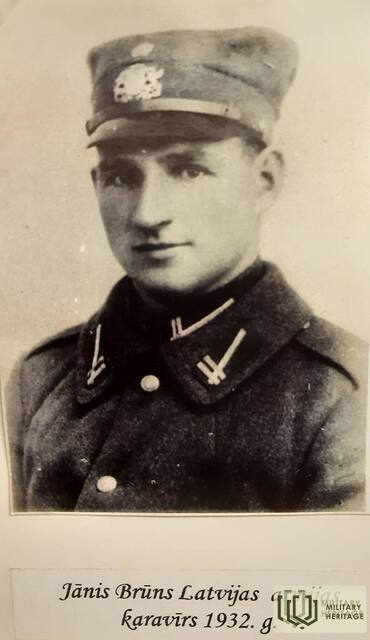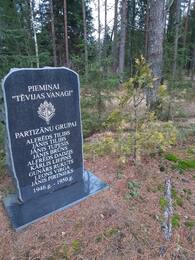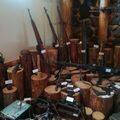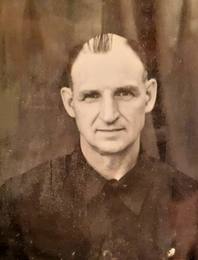Janio Tilibso prisiminimai apie partizanų būrį „Tėvo vanagai“
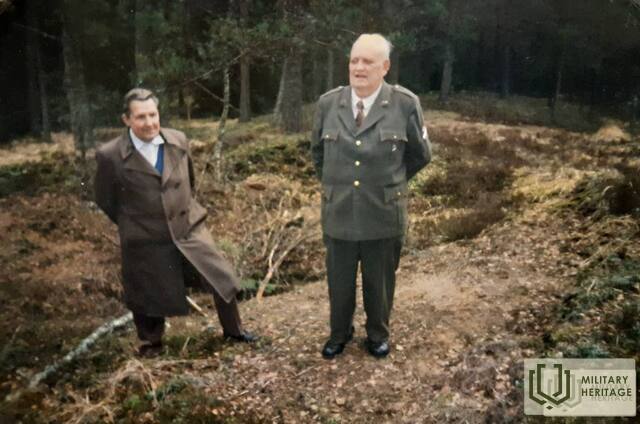
Jāņo Tilibso atsiminimai apie partizanų būrio „Tēvijas Vanagi“ veiklą Pietų Kuržemėje iki 1950 m.
1941 metų rudenį mano brolis Alfredas Tilibsas įstojo į Liepojos 21-ąjį policijos batalioną. 1942 metais jis išėjo į frontą. Fronte jis kovojo Volchove, kur 1943 metų pradžioje buvo sužeistas ir išsiųstas gydytis į Rygą. Jo brolis buvo vienas pirmųjų Latvijos legionierių, gavusių antrojo laipsnio Geležinį kryžių, apie kurį buvo rašoma to meto spaudoje. Laikraštyje taip pat buvo jo nuotrauka su apdovanojimu ant krūtinės.
1946 m. jo brolis buvo paleistas iš filtracijos stovyklos Maskvoje. Jis grįžo į tėvo namus „Aizkapiuose“, Bartos valsčiuje. Grįžęs jis pradėjo kurti nelegalią organizaciją pavadinimu „Patriotiniai vanagai“. Buvo suformuota partizanų grupė, kurią sudarė nacionalistai iš Bartos, Nycos ir Liepojos. Netrukus vietos komunistai pradėjo nešiotis laikraščius su jo nuotrauka ir Dzelzkrustais. Jie nerimavo, kad tokiems vyrams bus leista išeiti į laisvę. Mano brolis tai išgirdo ir nuėjo į mišką. Jo grupė „Patriotiniai vanagai“ pradėjo veikti. Kadangi Čeka negalėjo sugauti mano brolio, jie mane suėmė. Tuo metu man buvo tik 16 metų. Pakeliui į Liepoją pabėgau nuo Čekos ir prisijungiau prie brolio prie partizanų. Mano brolis vadovavo 18 žmonių grupei. Pamenu, buvo Jānis Brūnas iš Nycos, Gunārs Rukutis ir Jānis Pirtnieks iš Bartos. Kitų nepažinojau. Mes daugiausia buvome ginkluoti vokiškais ginklais: automatais, kulkosvaidžiais, vadinamaisiais „kauliniais pjūklais“.
1947 m. vasarą buvo įvykdytos kelios operacijos prieš čekistus ir vietos bendrininkus. 1947 m. rudenį čekas aptiko mūsų bunkerį. Mūšyje žuvo Gunārs Rukutis, Aivaras Roze, sunkiai sužeistas Jānis Brūnas. Iš grupės žuvo 6 žmonės.
Artėjant žiemai, pasidalijome į dvi grupes. Janio Bruno vadovaujama grupė liko Nicos miške, o aš, mano brolis ir keli kiti partizanai persikėlėme į Aizputės ir Kuldygos miškus. Žiemą praleidome ramiai ir 1948 m. vėl susijungėme. Buvome Kuldygos rajone. Kaip vėliau paaiškėjo, į grupę buvo infiltravęsis išdavikas, ir netrukus mūsų grupę užpuolė čekistai. Turlavos valsčiuje, netoli Platkų namų, mano brolis Alfredas Tilibas buvo sunkiai sužeistas. Gavęs šautą į kojas ir galvą, matydamas, kad kova pralaimėta, paskutinę kulką paleido į save.
Likau vienas. Grįžau pas Janį Brunsą į Nicos miestą. 1948 m. lapkričio 17 d. Bruno liepė man vykti į Gavieze parapiją žvalgytis, kad būtų galima surengti operaciją lapkričio 18 d. Vėlai vakare išėjus iš miško netoli vieno iš namų, mus pasitiko Čekos pasalos. Kilo mūšis, kuriame ir aš, ir Bruno buvome sunkiai sužeisti. Bruno buvo nušautas, bet aš, nors ir sunkiai sužeistas, buvau nutemptas atgal į stovyklą, esančią maždaug už 10 km.
1949 m. prasidėjo trėmimai ir beveik visi mūsų rėmėjai buvo išvežti. Tačiau tuo metu Latvijos kaime buvo daug Latvijos patriotų, daugiau nei komunistų. Miške gyvenau iki 1950 m. kovo mėn. Iš didelės grupės likome tik du: aš ir Jānis Pirtnieks. Bunkeris buvo atrastas ir mus užpuolė Čeka. Į bunkerį buvo įmesta granata. Buvau sunkiai sužeistas. Abu buvome suimti.
1950 metų rudenį mus, apie 10 žmonių, teisio karinis tribunolas. Mus nuteisė 25 metams kalėti. Buvau išsiųstas į Karagandą, kur gyvenau iki 1956 metų.
Susijusi laiko juosta
Susijusios vietos
„Dunčio bunkeris“ ir atminimo lenta „Patriotiniams vanagams“
„Dunco bunkeris“ su memorialine lenta „Patriotiniai vanagai“ yra Otankių savivaldybėje, toje vietoje, kur buvo įsikūręs pirmasis nacionalinio pasipriešinimo organizacijos „Patriotiniai vanagai“ partizanų grupės bunkeris.
1945/46 m. žiemą Bartos valsčiaus Ķīburi kaime trys patriotai vyrai, vadovaujami Alfredo Tilibo (buvusio 19-osios SS divizijos legionieriaus), įkūrė nacionalinį pasipriešinimo judėjimą „Tēvijas vanagai“, kuriame netrukus buvo apie 200 narių iš skirtingų vietovių: Liepojos, Aizputės, Nycos, Dunikos, Grobinios, Bartos, Gaviezės. Šis judėjimas kovojo už Latvijos išlaisvinimą.
Bunkerio, kuriame buvo apgyvendinti partizanai, dydis buvo 4 x 4 m, jis buvo pastatytas iš storų, horizontaliai sukrautų rąstų. Į jį buvo patenkama iš viršaus pro liuką, iš kurio augo maža pušis, o po ja – kopėčios. Liukai buvo per du aukštus, kiekviename iš jų buvo vieta miegoti 7–8 vyrams. Deja, bunkeris buvo rastas ir susprogdintas 1947 m.
Šiandien žemėje, kur buvo bunkeris, galima pamatyti įdubimą. Vieta yra miške ir į ją gali laisvai patekti visi, bet kuriuo metu, be išankstinio rezervavimo.
Netoliese yra pikniko vieta su pastoge.
Atminimo lenta atidengta 2005 m. rugsėjo 9 d. Granito stelą pastatė Latvijos nacionalinė partizanų asociacija bendradarbiaudama su Nycos savivaldybe, Bartos miškų ūkiu ir Rudes pradine mokykla.
Objektas turi regiono kultūros ir istorijos paminklo statusą.
Rendos nacionalinio pasipriešinimo judėjimo muziejus
Muziejus yra įsikūręs už kelių kilometrų nuo Rendos parapijos centro. Parodoje pasakojama apie 50 metų trukusį pasipriešinimo judėjimą Latvijoje: pasipriešinimą pirmajai sovietų okupacijai, pasipriešinimą nacistinės Vokietijos okupacijai ir ginkluotą bei nesmurtinį pasipriešinimą sovietų okupacijai. Paroda įsikūrusi dviejuose pastatuose. Pirmajame pastate saugomi pirmosios sovietų ir vokiečių okupacijos įrodymai. Parodoje eksponuojamas restauruotas tvarto pastatas, kuriame dėmesys sutelktas į Nacionalinį partizaninį karą. Tarp dviejų pastatų yra autentiško išplanavimo bunkeris ir kareivių naudoti apkasai. Netoli muziejaus Rendoje esantys kasinėjimai, blindažo aikštelė ir kliūčių ruožas tarnauja kaip jaunimo sargybinių ir visų susidomėjusiųjų treniruočių aikštelė. Apsilankymus būtina užsisakyti iš anksto.
Vienas didžiausių nacionalinių partizanų mūšių, vadinamas Āpūzniekų mūšiu, įvyko 1946 m. sausį netoli čia. Mūšyje Kabilės nacionalinis partizanų būrys nugalėjo daug didesnes okupacinės valdžios pajėgas. Mūšio vietoje, kurioje yra informaciniai stendai, dabar įrengta poilsio aikštelė.
Otankių senienų saugykla
Otankių vietos muziejus įsikūręs buvusios Rudės mokyklos kieme.
Gido pasakojimas apie bunkerį ir jo kūrėjus, jų tolesnį likimą. Galima apžiūrėti buvusios Rudės mokyklos mokinių sukurtą bunkerio maketą (pagal pačių partizanų pasakojimą) ir to meto miško teritorijos erdvinį žemėlapį su pažymėtais rėmėjų ir kontaktų namais. Surinkti bunkerio buities eksponatai.
Išankstinė paraiška telefonu 26323014 arba el. paštu lelde.jagmina@gmail.com.




